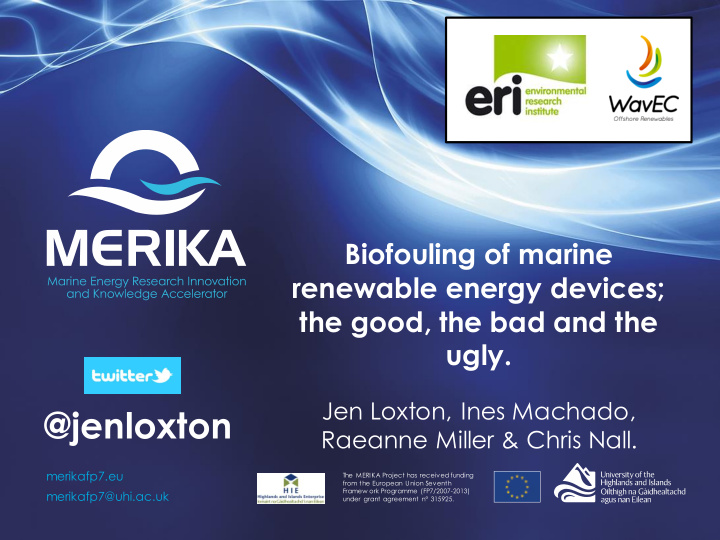



Biofouling of marine renewable energy devices; the good, the bad and the ugly. Jen Loxton, Ines Machado, @jenloxton Raeanne Miller & Chris Nall. merikafp7.eu The MERIKA Project has received funding from the European Union Seventh Framew ork Programme (FP7/2007-2013) merikafp7@uhi.ac.uk under grant agreement n° 315925.
Talk contents • Introduction to biofouling • The good – artificial reef effects • The bad – commercial and environmental implications • The ugly – non-native invasive species • Stakeholder consultation and highest priority issues • First results from MRE deployments. • Next steps merikafp7.eu merikafp7@uhi.ac.uk
What is biofouling?
Types of biofouling communities Intertida l – barnacles, algae Kelp Zone – kelps, barnacles, foliose algae Main column – mussels, anemones, soft corals, hydroids, tubeworms, barnacles Base – varies depending on scour protection and seabed mobility Hiscock, K., Tyler-Walters, H., Jones, H. (2002). AEA Technology, Environment Contract: W/35/00632/00/00. Rees, J., Larcombe, P., Vivian, C., and Judd, A. (2006). Scroby Sands Offshore Wind Farm – Coastal Process Monitoring. Final Report. CEFAS
Structural influences Free moving or static? • Floating or fixed? • Splash zone or intertidal zone? • Miller et al. (2013). Frontiers in Ecology and the Environment 11:8, 433-440
Biofouling happens in all industries • Particularly relevant in this one – devices are highly • tuned to extract optimum energy
The Good- artificial reef effects Aim of many MRE companies – no anti-fouling coatings. • High biodiversity • Increases productivity • Fish aggregation • Ecosystem services E.g. • Filtration • Carbon deposition • Primary production
The Bad- commercial & environmental implications Commercial • Weight • Density • Thickness • Roughness • Heat transfer coefficients
The Bad- commercial & environmental implications Commercial • Decreased efficiency of energy extraction • Decreased longevity of materials ( corrosion) • Increased maintenance costs
The Bad- commercial & environmental implications Environmental • Fish aggregation may increase risk of predator collision • May change local benthic community structure • Risk of non-native invasive species settlement and spread
The Ugly- non-native invasive species (NNIS) • Can be a licensing consideration • Risk of "polluter pays" legislation • Many NNIS are biofoulers • Arrays may act as stepping stones into "uncontaminated"areas • Multiple potential vectors: • Wet-towing devices • Servicing vessels • MRE harbours • Nearby industries e.g. Fish farms
We asked the experts…
Identifying issues & drivers Biofouling Concerns 25 20 15 10 5 0
First results from industry Biofouling scrape samples were collected for 5 MRE devices and extracted from scientific literature for other marine structures. Site Location Type latitude longitude reference 1 Heather A Shetland Offshore fixed oil platform 61.36304 1.579761 Picken (1986) 2 Orkney buoys Orkney Nearshore floating buoy 58.84953 -3.01148 A Macleod PhD (2013) 3 Floating Wave Orkney 4 Floating Tidal Orkney 5 Beatrice N. Scotland Offshore fixed oil platform 58.11667 -3.08333 Picken (1986) 6 Montrose Alpha oil N.E Scotland Offshore fixed oil platform 57.45065 1.388264 Forteath et al. (1982) 7 Floating wave array W Scotland 8 Skye buoys W Scotland Nearshore floating buoy 57.27505 -5.71501 A Macleod PhD (2013) 9 Princess Amalia wind Netherlands offshore fixed wind 52.59 4.22 Vanagt et al. (2013) 10 Horns Rev windfarm Denmark offshore fixed wind 55.50001 7.820015 Leonhard & Pederson (2006) 11 OWEZ Netherlands offshore fixed wind 52.606 4.419 Bouma Lengkeek (2012) 12 Thornton Bank wind (2009) Belgium offshore fixed wind 51.54548 2.92978 Kerckhof et al (2010) 13 Floating wind N. Portugal 14 Aguda sea wall N. Portugal Inshore fixed seawall 41.04815 -8.65674 Santos J (2008) 15 coastal OWC Azores 16 Azores Azores natural shoreline 36.97 -25.1 Botehlo + (2009)
High level biofouling data
Summary of preliminary results • Biofouling of up to 60kg/m2 recorded • Broadly speaking, location matters. (e.g. Scotland vs Portugal) • Biofouling in the top ~3m of floating structures is different to biofouling on fixed structures and at greater depths. • Invasive species were found on all but 1 renewable energy device BUT they have not necessarily been introduced on the device and may already have been widespread in the area.
Next steps: Ongoing experiments to get • more refined biofouling data from MRE deployments Have a better steer on • stakeholder needs Peer reviewed publications • (Loxton et al. and Machado et al.) – watch this space! Biofouling prediction project • – in development – Incorporating key issues and drivers
WANTED Any potential collaborators who have or could facilitate access to MRE test devices or test sites. Contact: Jennifer.loxton@uhi.ac.uk @jenloxton Thanks Co-authors Chris Nall Ines Machado Raeanne Miller All developers and test site owners who helped us sample their sites. Thank you for listening
Recommend
More recommend